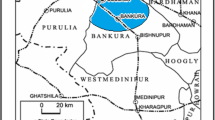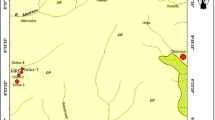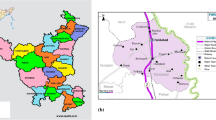Abstract
Wastewater samples were collected from Al-Rustumia wastewater treatment plant. The methodology which was used to measure radon activity levels was long-term air measurements with passive solid-state alpha track detector CR-39. The collected samples include wastewater before and after treatment for 5 months which started from September 2017 to January 2018. The results show that the average values of radon activity level for untreated and treated wastewater samples were 0.049 Bq L−1 and 0.036 Bq L−1, respectively. Dissolved radon concentrations for the study samples were also calculated and their values were 1.270 Bq L−1 and 0.937 Bq L−1, respectively. The calculated radon surface exhalation rate for wastewater samples before treatment was 0.048 Bq m−2 h−1 and after treatment was 0.035 Bq m−2 h−1. These values are lower than the maximum acceptable radon levels as given by United States Environmental Protection Agency. As well as, the results reveal that radon activity level decreases after treatment process implementation, and there are no considerable variations with different times of the year.
Similar content being viewed by others
Avoid common mistakes on your manuscript.
Introduction
Wastewater reuse is an essential part of water needs which enhances the preservation of purity of freshwater as well as decreasing the environmental pollution and the total supply costs. Developments in technology encourage the developing countries to take efforts toward the wastewater reuse (Al-Jayyousi 2003; Al-Hamaiedeh and Bino 2010).
Rapid growth of population, urbanization, development of sanitation service, and scarcity of freshwater increase the demand for the reuse of treated wastewater (Shaker et al. 2014; Alobaidy et al. 2010; Yadav et al. 2002; Qadir et al. 2009).
Wastewater originates from many sources, e.g., domestic, which is concerned as the largest source, commercial, and industrial sources (Eriksson et al. 2002; Flowers 2004). Irrigation with treated wastewater should be managed carefully in order to reduce the negative environmental impacts and can be more useful to the environment (WHO 2005).
The use of treated wastewater for irrigation, which is currently widely used, is suggested as an alternative way for irrigation due to scarcity of freshwater (DHWA 2002). Hence, TWW should be examined carefully in order to make certain that it meets Iraqi National Standards set by the Regulation 25 of 1967.
In previous studies on wastewater of Al-Rustumia plant, different indices such as Comprehensive Pollution Index (CPI) and organic pollution index (OPI) and hazardous parameters such as electrical conductivity (EC), total dissolved solids (TDS), sodium (Na+), sodium adsorption ratio (SAR), soluble sodium percent (SSP), residual sodium carbonate (RSC), chloride (Cl−),biological oxygen demand (BOD5), chemical oxygen demand (COD), total suspended solids (TSS), and pH have been measured, in order to distinguish the contamination of the wastewater and furthermore to assess its appropriateness for irrigation purposes (Shakir et al. 2017; Ismail 2013). However, there is lack of researches on naturally occurring radioactivity and radon on wastewater of Al-Rustumia plant.
The environmental radioisotopes may enter the system of the sewage treatment through three sources; they are (ISCORS 2005):
- 1.
Transportation of radioactive materials (such as uranium, radium, thorium, radon, and other nuclides), from the geological formations and soils that contain them to the water that moves through it. These radioactive materials may dissolve in the water itself or linked to suspended particles in the water.
- 2.
Technologically Enhanced Naturally Occurring Radioactive Materials (TENORM) may enter the sewage framework from ground and surface water, plants and sustenance and in addition from manufacture releases (e.g., water treatment plants, mining and oil enterprises, manures, gadgets, earthenware production, foundries, and paper factories).
- 3.
Man-made radioactive materials may also be found in the environment due to accidents and weapon testing, for example, radionuclides produced from nuclear reactors processes, accelerators, industrial activities, researches, and nuclear medicine.
Radon occurs naturally in the environment; it is one of 238U decay series products and provides a continuous source of radiation. Radon has low solubility in water (ICRP 2014) which is temperature dependent, and it decreases at higher temperatures (Battino 1979). Radon is trapped by plant organs by diffusion, adsorption, and permeation (Tavera et al. 2002; Vives et al. 2011).
The objective of this research is to measure radon activity concentrations in the untreated and treated wastewater samples collected from Al-Rustumia (WWTP) by using solid-state nuclear track detector CR-39 and to assess its appropriateness for irrigation purposes.
Materials and methods
Site description
Baghdad, the capital city of Iraq, is situated on the Tigris River, and it is 25 km apart from the nearest point to Euphrates River to the west. Tigris River meets Diyala River at the southeast of Baghdad and borders its eastern suburbs. The population of Baghdad, as of 2016, is approximately 8,765,000, making it the largest city in Iraq. In the period between 1960 and 1980, the sewerage network was founded to work on the principle of separate systems. In 1980, a combined system was established and has been adopted since then. The capacity of the zero stage, which was created in 1960, was 40,000 m3 day−1 which served about 24% of Baghdad’s inhabitants only by full sewage processing. The first extension (stage 1) was added and partly combined with the zero stage in 1974 with capacity equal to 45,000 m3 day−1. Finally, the second extension (stage 2) was combined with capacity equal to 90,000 m3 day−1 in 1981. Thus, the total capacity of the system became 175,000 m3 day−1 and serves the east bank of Tigris River.
In 1985, Al-Rustumia (WWTP) (stage 3) was built on the Diyala River (44° 52′ 69.98″ E, 33° 27′ 38.82″ N) and operated to serve a total of 1,500,000 inhabitants (Palmer Steve 2004; WHO 2005). After treatment, the drainage is discharged to the Diyala River which in turn results in the Tigris River. A map of part of Baghdad city is given in Fig. 1, which shows the location and the coordinates of Al-Rustumia (WWTP).
Sampling
Wastewater samples were collected from Al-Rustumia (WWTP) and analyzed to measure the radon levels before and after treatment. The samples were collected for 5 months which started from September 2017 to January 2018 in order to study the variation of radon concentrations with the variation of weather temperatures.
Sealed-can technique, which is shown in Fig. 2, is used to determine the radon levels in the wastewater samples. Three iterations of each sample were carried out. Solid-state plastic detectors CR-39 of thickness ~ 500 μm and area (~ 1.5 × 1 cm2) were used. The samples were left for 60 days of exposure. After exposure, the samples were immersed in 6.25N NaOH etching solution at 70 °C for 5 h in order to make alpha tracks visible with an optical microscope. Then, when the detectors were taken out of NaOH solution, they were washed with tap water, distilled water and finally with alcohol solution. Eventually, α-tracks were counted using an optical microscope with a magnification of 400×.
Calculation
The track densities (ρ) in the samples are calculated using Eq. (1) (Amalds et al. 1989):
Radon concentration (CRn) in (Bq L−1) in the wastewater samples is calculated by the following equation (Salih et al. 2015):
where ρ = the measured α-track density (Track cm−2), T = the time of exposure and CF = the calibration factor which is calculated using Eq. (3) (Hussein et al. 2013):
where R = the radius of the container (cm), θc = 35° = CR-39 critical angle, and Rα = 4.15 cm = the range of α particles emitted from 222Rn. The calculated value of CF = 0.04891 Track cm−2 d−1 Bq−1 L−2.
Equations 4 and 5 are used to calculate the dissolved radon concentration (Cdis) in wastewater samples in terms of (Bq L−1) and radon surface exhalation rates (RERS) in Bq m−2 h−1, respectively (Ismail and Jaafar 2009):
where CRn = the radon concentration in the sample (Bq L−1), λ = 222Rn decay constant (h−1), h = the distance between the water surface and the detector (m), T = the exposure time (h), L = the depth of the sample (m), C = the total radon exposure (Bq L−1 h), V = the air volume in the cup (L), and A = the surface area of the sample (m2).
Results and discussion
Table 1 and Fig. 3 present the obtained results of radon activity levels in wastewater samples before and after treatment for 5 months. The average values of radon activity levels for untreated and treated samples were found to be 0.049 Bq L−1 and 0.036 Bq L−1, respectively. The results show that radon activity levels decrease after the treatment process for all samples, whereas there are no major variations at different times of the year.
The dissolved radon concentrations, which are calculated using Eq. (4), for untreated and treated wastewater samples are shown in Fig. 4. The average value of the dissolved radon concentrations of untreated wastewater samples is 1.270 Bq L−1, while the average value of treated wastewater samples is 0.937 Bq L−1. The calculated dissolved radon concentrations for wastewater samples before and after treatment are also given in Table 1. The results show that there is an excess radon level during January, and this may be due to that January is the rainier month in Iraq during the year.
Figure 5 presents radon exhalation rate in terms of surface for the study wastewater samples. The average values of untreated and treated wastewater samples were found to be 0.048 Bq m−2 h−1 and 0.035 Bq m−2 h−1, respectively.
It is clear from the obtained results that the treated wastewater samples do not perform any important source of radiation risk and can be considered safe to reuse in irrigation in so far as radon concentration is concerned. However, values of radon activity in untreated and treated wastewater samples are less than the EPA contaminant level (11.1 Bq L−1) (Tawfiq et al. 2015).
Conclusions
In this study, measurements of CRn, Cdis, and RERS in wastewater samples before and after treatment collected from Al-Rustumia WWTP were obtained. We conclude that:
- 1.
The average values of CRn for untreated and treated wastewater samples were 0.049 Bq L−1 and 0.036 Bq L−1, respectively, which are below the world permissible value of 11.1 Bq L−1 given by USEPA (2012).
- 2.
The average values of Cdis for untreated and treated wastewater samples were 1.270 Bq L−1 and 0.937 Bq L−1, respectively.
- 3.
Overall average surface exhalation rate of radon RERS for untreated and treated wastewater samples were 0.048 Bq m−2 h−1 and 0.035 Bq m−2 h−1, respectively.
- 4.
Radon activity level decreases after the treatment process.
- 5.
No remarkable variations found in radon activity level of the wastewater samples during the period of study.
- 6.
Therefore, as from radiological point of view, the treated wastewater taken from Al-Rustumia WWTP is safe to be reused in irrigation and does not pose any considerable radiation hazards.
References
Al-Hamaiedeh H, Bino M (2010) Effect of treated grey water reuse in irrigation on soil and plants. Desalination 256:115–119
Al-Jayyousi OR (2003) Gray water reuse: towards sustainable water management. Desalination 156(1–3):181–192
Alobaidy AHM, Al-Sameraiy M, Kadhem AJ, Abdul Majeed A (2010) Evaluation of treated municipal wastewater quality for irrigation. J Environ Prot 1(3):216–225
Amalds O, Custball NH, Nielsen GA (1989) Cs-137 in Montarq soils. Health Phys 57(6):955–958
Battino R (1979) Radon-222. In: Cleve HL (ed) Krypton, xenon & radon. IUPAC SolubilityData Series, vol 2. Pergamon Press, New York, pp 227–338
DHWA Department of Health Western Australia (2002) Draft guidelines for the reuse of greywater in Western Australia. Department of Health, Perth, p 37
Eriksson E, Auffarth K, Henze M, Ledin A (2002) Characteristics of grey wastewater. Urban Water 4:85–104. https://doi.org/10.1016/S1462-0758(01)00064-4
Flowers B (2004) Domestic water conservation: greywater, rainwater and other innovations. Canadian Standards Council. http://www.csa.com/discoveryguides/wateroverview.php
Hussein ZA, Jaafar MS, Ismail AH (2013) Measurement of radium content and radon exhalation rates in building material samples using passive and active detecting techniques. Int J Sci Eng Res 4(9):1827–1830
ICRP (2014) Radiological protection against radon exposure. ICRP Publication 126. Ann. ICRP 43(3). Fontenay-aux-Roses: SAGE Publications, p 183
ISCORS Interagency Steering Committee on Radiation Standards (2005) Assessment of radioactivity in sewage sludge: recommendations on management of radioactive materials in sewage sludge and ash at publicly owned treatment works. Technical Report 2004-04
Ismail AH (2013) Cluster analysis of some ecological properties in Al-Rustamiyah wastewater treatment plant 3rd expansion at Baghdad city, Iraq through (2006–2011). J Kerbala Univ 11(1):195–203
Ismail AH, Jaafar MS (2009) Experimental measurements on CR-39 response for radon gas and estimating the optimum dimensions of dosimeters for detection of radon. In: Proceedings of the 3rd Asian physics symposium, Bandung, Indonesia July 22–23, pp 407–411
Palmer Steve J (2004) Rehabilitation of Al-Rustamiya sewage treatment plant works-3rd extension, 1st ed. Bechtel International United Company, USA, 2004 (Project No. 617-24910)
Qadir M, Wichelns D, Raschid I, McCornik PG, Drechsel P, Bahri A, Minhas PS (2009) The challenges of wastewater irrigation in developing countries. Agric Water Manag 97(4):561–568
Salih NF, Jafri ZM, Jaafar MS (2015) Measurement of radon concentration, and uranium concentration in drinking water in Kirkuk governorate. J Sci Res Dev 2(13):127–131
Shaker EA, Al Obaidy AHM, Al Mendilawi HR (2014) Environmental assessment of wastewater treatment plants (WWIPs) for old Rustamiya project. Int J Sci Eng Technol Res (IJSETR) 3(12):3455–3459
Shakir EA, Zahraw Z, Al-Obaidy AMJ (2017) Environmental and health risks associated with reuse of wastewater for irrigation. Egypt J Pet 26(1):95–102
Tavera L, Balcazar M, Villalobos-Pietrini R, Flores-Marquez AR, Meneses PMA (2002) Dosimetric assessment of radon in a vegetable system. Radiat Environ Biophys 41:289–293
Tawfiq NF, Mansour HL, Karim MS (2015) Measurement of radon gas concentrations in tap water for Baghdad governorate by using nuclear track detector (CR-39). Int J Phys 3(6):233–238. https://doi.org/10.12691/ijp-3-6-2
USEPA (2012) Report Drinking Water Standards and Health Advisories
Vives I, Batlle J, Smith A, Vives-Lynch S, Copplestone D, Prohl G, Strand T (2011) Model-derived dose rates per unit concentration of radon in air in a generic plant geometry. Radiat Environ Biophys 50:513–529
WHO (2005) A Regional Overview of Wastewater Management and Reuse in the Eastern Mediterranean Region. World Health Organization, Regional Office for the Eastern Mediterranean Regional, California Environmental Health Association, Geneva
Yadav RK, Goyal B, Sharma RK, Dubey SK, Minhas PS (2002) Post-irrigation impact of domestic sewage effluent on composition of soil, crop and ground water—a case study. Environ Int 28(6):481–486
Author information
Authors and Affiliations
Corresponding author
Additional information
Publisher's Note
Springer Nature remains neutral with regard to jurisdictional claims in published maps and institutional affiliations.
Rights and permissions
Open Access This article is distributed under the terms of the Creative Commons Attribution 4.0 International License (http://creativecommons.org/licenses/by/4.0/), which permits unrestricted use, distribution, and reproduction in any medium, provided you give appropriate credit to the original author(s) and the source, provide a link to the Creative Commons license, and indicate if changes were made.
About this article
Cite this article
Amin, S.A., Al-Ani, R.R. Naturally occurring radon assessment in Al-Rustumia wastewater treatment plant. Appl Water Sci 9, 179 (2019). https://doi.org/10.1007/s13201-019-1074-x
Received:
Accepted:
Published:
DOI: https://doi.org/10.1007/s13201-019-1074-x









